In the vast landscape of Illinois, an intricate network of dams plays a pivotal role in shaping the state’s water resources. These structures, whether colossal or compact, contribute significantly to a variety of essential functions—from flood control and water supply to power generation and even recreation.
Illinois, nestled in the heartland of America, has several rivers and lakes. It’s here that dams come into play, acting as guardians and stewards of these valuable natural resources. By harnessing the waters effectively and sustainably, they provide a multitude of benefits to the people and wildlife of Illinois.
The dams of Illinois are feats of engineering brilliance, but they also serve as a testament to the delicate balance between human infrastructure and environmental preservation.
In this article, we discover the largest dam in Illinois and what would happen if it ever broke. Then, we take you on a journey of discovery. There’s a lot to explore, from the history of the dam to the wildlife that inhabits its waters
The Largest Dam in Illinois
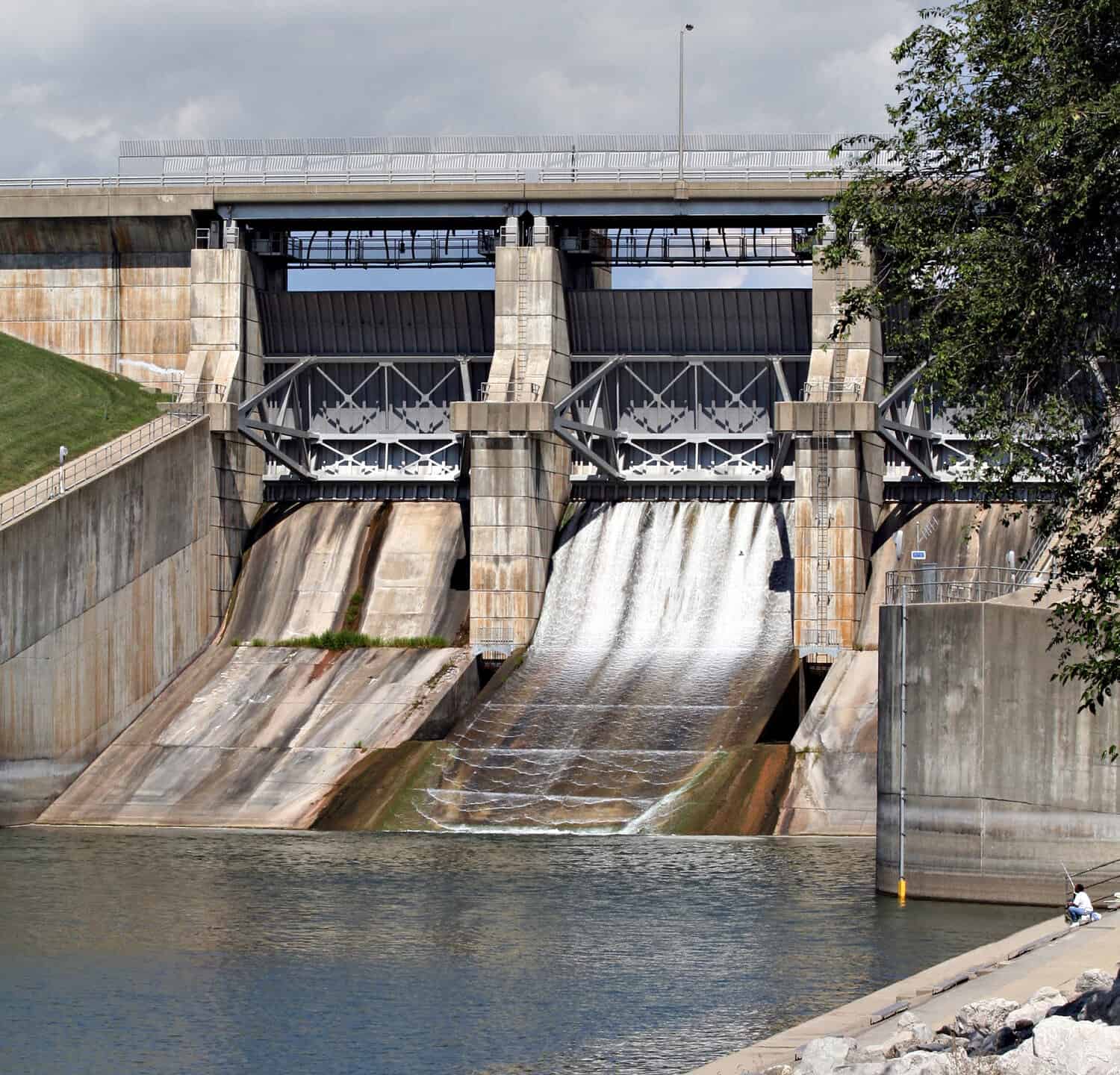
This facility is a popular location for fishing, picnicking, and walking trails.
©Charles Brutlag/Shutterstock.com
The Lake Shelbyville Dam is the largest dam in Illinois. Nestled in the heart of Illinois, this colossal structure plays a crucial role in a whole host of areas:
- Flood control
- Power generation
- Recreation
It’s the backbone of the local community and the guardian of the stunning Lake Shelbyville.
The Dimensions: A Behemoth in Concrete and Steel
The Lake Shelbyville Dam in Illinois is a giant by any standard. It stands at a staggering 108 feet high and stretches over 3,025 feet long. And, mind you, it’s not just tall and long but also wide, with a crest width of 50 feet and a base width of 1,250 feet. It consists primarily of earth fill and concrete, buttressed by an inner steel framework that provides extra strength and stability.
The Design: A Blend of Engineering Wisdom
The Lake Shelbyville Dam boasts a gravity dam design, one of the most common and reliable in dam engineering. This design uses the structure’s weight and material (in this case, earth fill and concrete) to resist the pressure of the water it holds back. The dam’s curved form further aids in distributing the water pressure to its base, thereby enhancing its overall stability and durability.
Lake Shelbyville: More Than Just a Reservoir
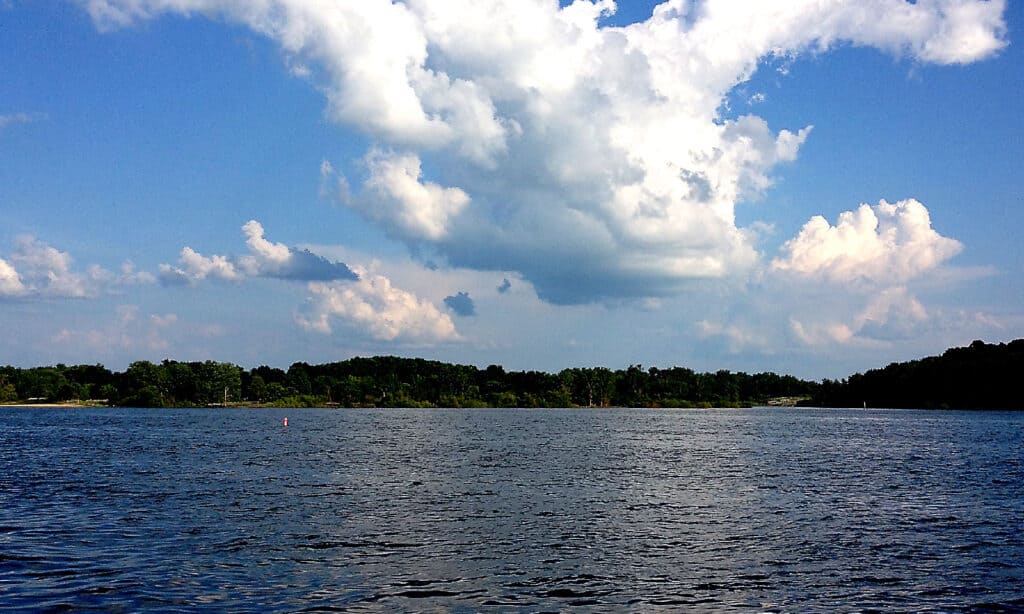
Lake Shelbyville provides an extensive amount of amenities and some of the best largemouth bass fishing in the Midwest
©iStock.com/GagasGarden
Sitting behind the dam is the mighty Lake Shelbyville, a reservoir that is an engineering feat in its own right. It spans an impressive 11,100 acres and reaches depths of up to 67 feet. It’s not just a water storage facility, though. It plays a crucial role in flood control, power generation, and even recreation, offering fishing, boating, and swimming opportunities to locals and tourists alike.
The Floodgates and Power Generation
A crucial part of the dam’s functionality is its floodgates, designed to control the water level in the lake and release excess water when necessary. Attached to the dam is a hydroelectric power plant, a testament to engineering genius, harnessing the power of the Kaskaskia River’s water to generate clean, renewable electricity for the region.

Where is Lake Shelbyville Dam Located on a Map?
Ever thought about the precise geographical positioning of the Lake Shelbyville Dam? Located within the rich heartland of Illinois, this noteworthy landmark does more than simply exemplify engineering prowess. So let’s dive deeper into the specifics of its location.
Nestled in Central Illinois
The Lake Shelbyville Dam resides centrally within the Land of Lincoln—Illinois. Situated about 195 miles southwest of Chicago, roughly 98 miles northeast of St. Louis, and approximately 32 miles southwest of Decatur. It is an accessible attraction for locals and tourists journeying from these bustling urban centers.
Sandwiched Between Shelbyville and Sullivan
The dam finds itself enveloped by two quintessentially American towns—Shelbyville and Sullivan. These small, friendly communities, with their picturesque settings, serve as gateways to the dam. The dam is not merely a geographical point of interest here but also a significant aspect of the cultural and economic fabric of these towns.
Draped in Illinois’ Bountiful Landscape
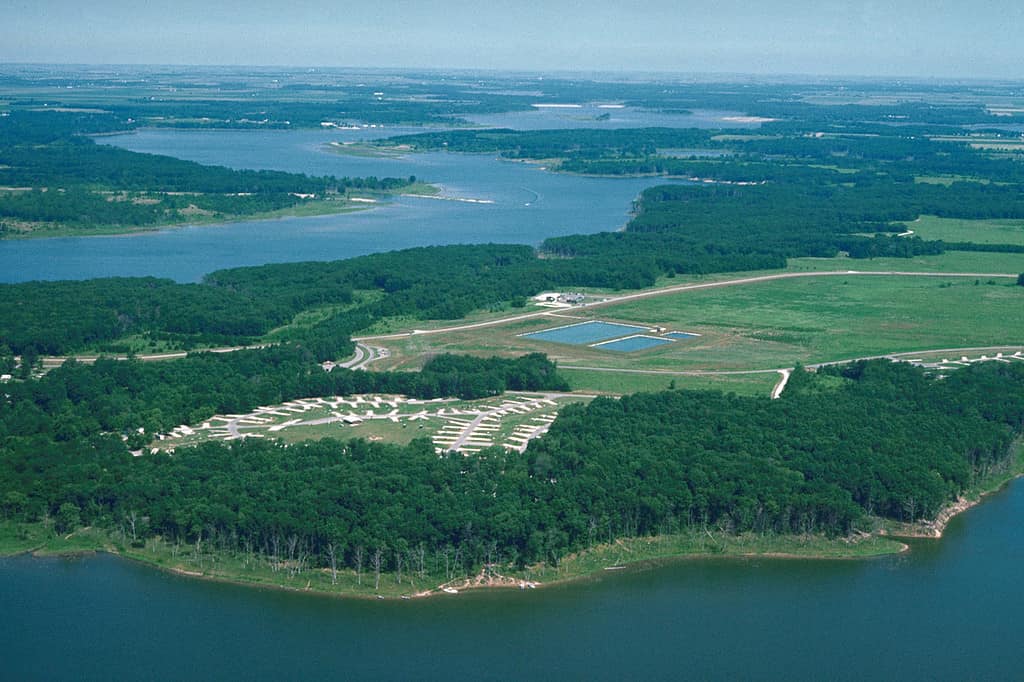
Shelbyville Lake on the Kaskaskia River near Shelbyville, IL.
©U.S. Army Corps of Engineers, photographer not specified or unknown, Public domain, via Wikimedia Commons – License
Let’s paint a picture of the encompassing landscape. Cradled within an area characterized by undulating hills adorned with a tapestry of lush green woodlands. Beyond the forests, expansive farmlands undulate across the horizon. Finally, the Lake Shelbyville Dam, an imposing sentinel over the landscape, majestically straddles the Kaskaskia River.
Guardian of the Kaskaskia River
The Kaskaskia River, which the dam overlooks, is a noteworthy mention. It is a major tributary of the Mississippi River, snaking through the state of Illinois and serving as a crucial waterway. The dam, through its control of this river, plays a pivotal role in managing the state’s water resources, flood control, and even power generation.
Historical Background of Lake Shelbyville Dam
Let’s explore the intriguing backstory of the Lake Shelbyville Dam, examining the intricate details that led to its conception and realization.
The Genesis of an Idea
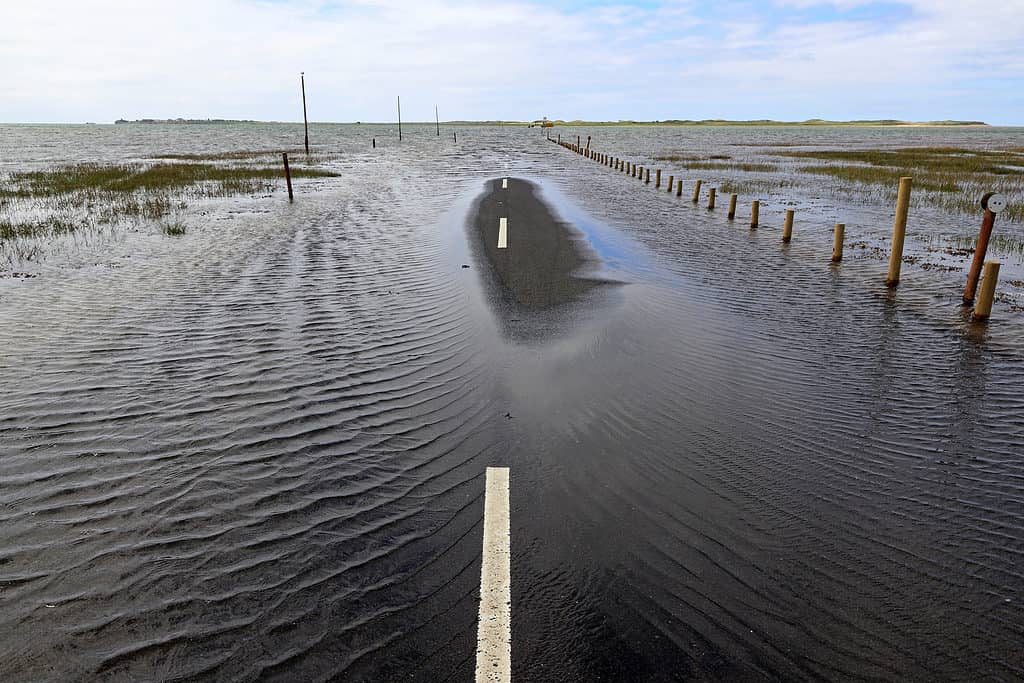
Severe floods can cause major damage to the land and crops of locals.
©iStock.com/Astrid860
Lake Shelbyville Dam was conceived with practicality in mind. Kaskaskia River often overflowed its banks during heavy rainfalls in the early decades of the 20th century, causing severe damage to agricultural lands and affecting the livelihoods of locals.
In the late 1930s, recognizing the recurring issue, local and state authorities started to explore a lasting solution to these flood concerns. After much debate and consideration, the idea of a dam emerged. The dam would not only regulate the flow of the Kaskaskia River, reducing flood risks but also serve as a reliable water supply and a potential source of hydroelectric power.
Key Players in the Construction
Enter the U.S. Army Corps of Engineers. The dam was created by this federal agency with a strong track record in engineering feats across the country. This was a team of competent engineers, architects, and construction workers ready to rise to the challenge and turn the blueprint of the dam into a tangible reality.
The Journey from 1963 to 1970
The first cornerstone of the dam was ceremoniously laid in 1963. From that point forward, work was underway in earnest. Teams worked tirelessly over the course of the following seven years, through Illinois’ sweltering summers and bone-chilling winters, to construct the mammoth structure. Finally, in 1970, their labor bore fruit as the Lake Shelbyville Dam was officially completed and operational.
Facing the Challenges Head-On
The journey was not without its trials and tribulations. The team faced a myriad of challenges, ranging from technical complications arising from the sheer scale of the project to logistical issues with procuring necessary materials. At times, there were even budgetary constraints that threatened to halt the project. However, with unwavering resolve, they navigated each problem, devising solutions that kept the project on track, ultimately leading to its successful completion.
How Was Lake Shelbyville Dam Built?
How did the towering Lake Shelbyville Dam come into being? Let’s explore how this engineering marvel came to be. So, with hard hats on and blueprints in hand, let’s step onto the construction site!
Blueprint to Reality
First things first, every large project needs a well-thought-out blueprint. For the Lake Shelbyville Dam, expert architects and engineers spent countless hours drafting detailed plans. These plans dictated everything, from the dam’s enormous size to its unique structural features, ensuring that the final product would be a safe, efficient, and long-lasting piece of infrastructure.
Gathering the Building Blocks
Building a dam requires an enormous amount of materials. And we’re not talking about run-of-the-mill bricks and mortar here. The Lake Shelbyville Dam needed tons of concrete, steel, and earth fill. Organizing the logistics for such vast quantities was a task in and of itself, but the team pulled it off with precision.
The Power of Machinery
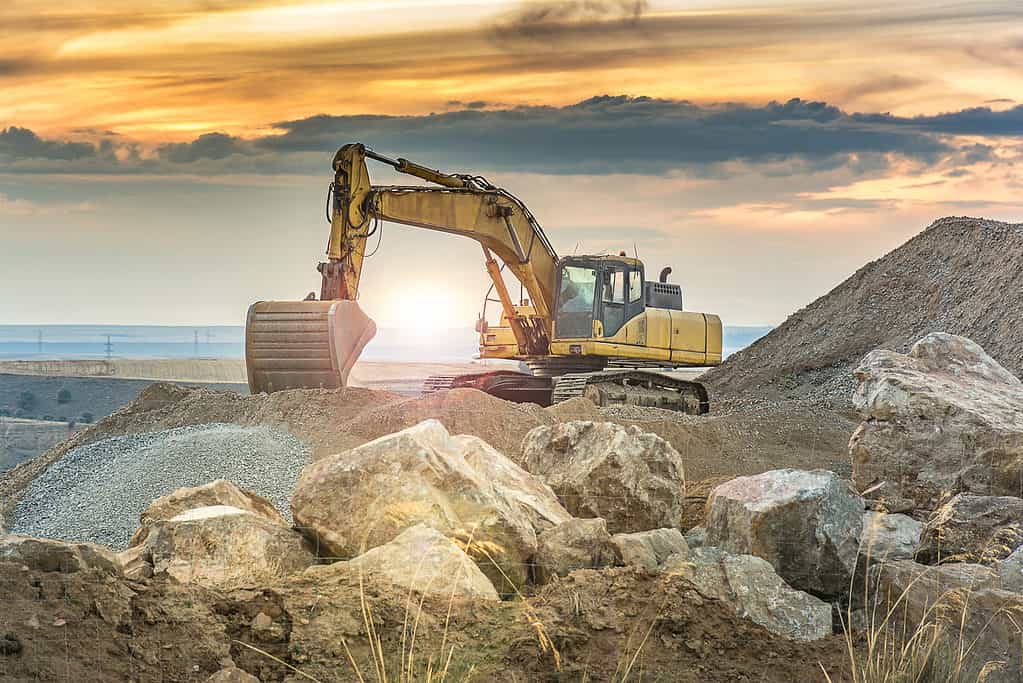
Crews worked for seven years to build the Shelbyville Dam.
©iStock.com/Juan-Enrique
Imagine lifting those heavy materials into place without the help of machinery. Impossible, right? That’s why the construction site was filled with powerful machines. From towering cranes to massive dump trucks and concrete mixers, these mechanical workhorses were invaluable to the project’s success.
Safety First
Safety was paramount throughout the construction process. Stringent safety protocols were implemented to protect the workers involved. Regular inspections, safety drills, and protective gear were all part of the daily routine on the construction site.
The Final Stages
Once the main structure was in place, it was time for the final stages. These included installing the floodgates, setting up the hydroelectric power plant, and landscaping the surrounding area. When all was said and done, the once-empty spot along the Kaskaskia River was transformed into the awe-inspiring Lake Shelbyville Dam we see today.
The Wildlife of Lake Shelbyville
Ready to embark on a virtual wildlife safari? Let’s explore the thriving ecosystem that calls Lake Shelbyville home. From the smallest fish to the majestic bald eagles, the lake and its surroundings are a haven for nature’s wonders. So let’s put on our explorer’s hat and dive in!
Fish

Largemouth bass are among the many species thriving in Lake Shelbyville.
©iStock.com/stammphoto
First up, let’s dive into the waters of Lake Shelbyville. Renowned as a fisherman’s paradise, the lake boasts an impressive variety of fish. Anglers might reel in everything from largemouth bass and smallmouth bass to walleye, crappie, and catfish. Each species adds its own unique charm to the aquatic diversity of the lake.
Birds

Green herons are only 17 inches long from beak to tail, a common sight on Lake Shelbyville.
©Bill Perry/Shutterstock.com
Raise your eyes to the sky, and you might catch a glimpse of the magnificent birds that populate the area. The lake has great birdwatching opportunities. You can often see majestic bald eagles soaring above the water. Other avian inhabitants include herons, hawks, and a variety of waterfowl. It’s like a live-action nature documentary right here at Lake Shelbyville.
Mammals and More
The area around the lake isn’t to be outdone by the water and sky. Here, you might encounter deer grazing near the water’s edge, squirrels darting among the trees, and raccoons foraging for food. You can even spot elusive creatures like foxes and coyotes.
What Would Happen If It Ever Broke
Ever wondered about the “what ifs” of the Lake Shelbyville Dam? Like, what would happen if it ever broke? It’s a scary thought, isn’t it? While the dam is designed to withstand a lot, this hypothetical scenario is important to consider. So, brace yourself as we delve into the potential consequences of a dam break.
Flooding: The Immediate Aftermath
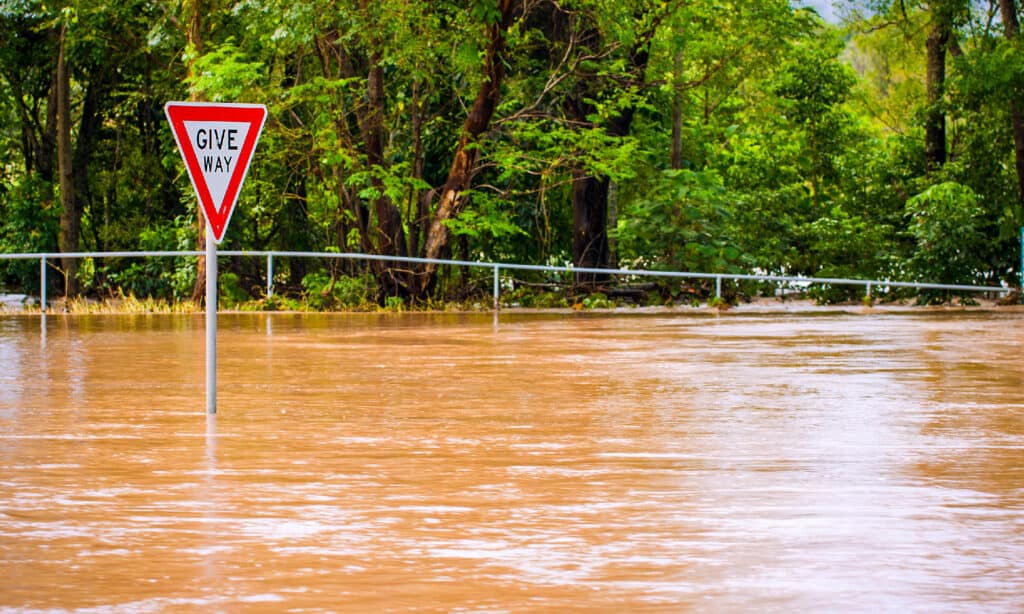
As little as one foot of water can move most cars off the road!
©iStock.com/Jaykayl
Let’s state the obvious first: if the dam broke, it would result in an immediate and massive release of the water stored in Lake Shelbyville. This would lead to severe flooding of the Kaskaskia River and the lands and communities downstream. The magnitude of the flooding would hinge on a variety of determinants, such as:
- The volume of water in the lake at the time
- The nature of the breach
Infrastructure Damage: The Domino Effect
A flood of this magnitude would not only inundate lands but could cause significant damage to infrastructure. Roads, bridges, buildings, and utilities might be damaged or destroyed. The costs associated with repairing or replacing these could be astronomical.
Environmental Impact: A Setback for Nature
An uncontrolled release of water could also wreak havoc on local ecosystems. For example, a sudden flood could destroy habitats and displace or harm wildlife. Plus, the damage to the aquatic life in Lake Shelbyville could be substantial, disrupting the balance of the local ecosystem for years to come.
Power Disruption: Lights Out
Given the dam’s role in power generation, a breach could disrupt the local power supply. This might cause power outages in the short term and necessitate alternative power sources or solutions in the longer term.
A Wake-Up Call for Safety Measures
Despite the grim picture painted above, it’s crucial to remember that dams like Lake Shelbyville are designed and built with safety as the top priority. They’re engineered to withstand extreme weather and seismic events, and they undergo regular safety inspections and maintenance. Also, in the unlikely event of a dam failure, emergency response plans are in place to protect communities and minimize damage.
Key Takeaways
So, we’ve journeyed through the history, structure, and operations of the impressive Lake Shelbyville Dam. Isn’t it amazing how this single structure can play so many roles, from controlling floods to generating power, supporting wildlife, and even offering us a place for recreation and relaxation? But, as we’ve discovered, it’s more than just the largest dam in Illinois.
It’s a linchpin for the local community, a haven for wildlife, and a testament to human ingenuity. It’s a symbol of the delicate balance between human development and environmental preservation, showing us that we can indeed coexist and even thrive alongside nature.
The photo featured at the top of this post is © railway fx/Shutterstock.com
Thank you for reading! Have some feedback for us? Contact the AZ Animals editorial team.






